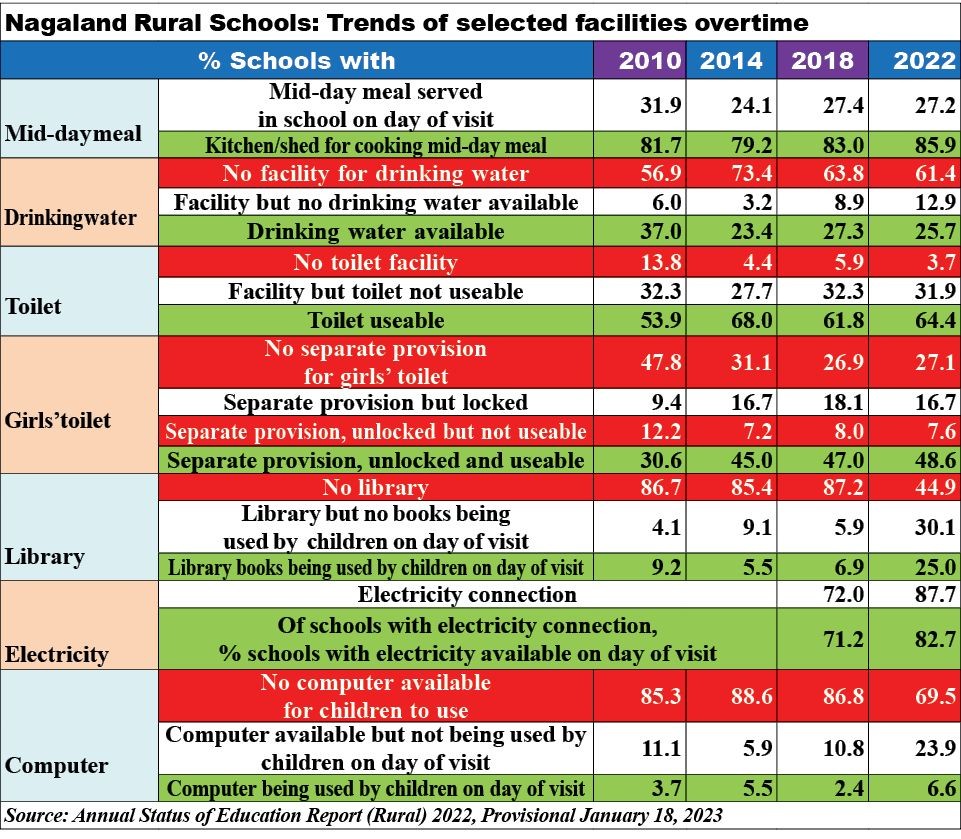
Library surges; access to drinking water still lacking: ASER
Morung Express News
Dimapur | January 29
Despite improvement in recent years, computers are not available in nearly 70% of rural schools in Nagaland, informed the latest Annual Status of Education Report (ASER) 2022.
Accordingly, in 2022, no computers were available in 69.5% of the schools surveyed, while in 23.9% of the schools, computers were available “but not being used by children on day of visit.”
Only in 6.5% of the schools, computers were ‘being used by children on day of visit.’
However, the trends in availability of facilities in schools from 2010-2022 provided in the survey informed that it was an improvement from 2018, when 86.8% of the schools had no computer. It was 85.3% in 2010 and 88.6 in 2014.
The All-India average of schools without computer was 77.3%.
Meanwhile, there was slight improvement in provision of drinking water, but accessibility remains a big challenge with the survey highlighting that 61.4% of the schools were without facility for drinking water in 2022. In 2018, it was 63.8%.
Again, in schools where there were facilities for drinking, there was no water in 12.9%.
Accordingly, only in 25.7% of the schools surveyed had water available for drinking and nearly 75% without one.
The status was abysmally low when compared with the national average of just 12.4% without facility for drinking water.
Facilities for toilet and mid-day meal between 2018 and 2022 also improved in Nagaland, though school without separate provision for girls' toilet increased from 26.9% to 27.1% during the same period.
Overall, however, school without toilet facility declined from 5.9% in 2018 to 3.7% in 2022. However it was below national average of 2.9% in 2022.
Out of the total available toilets in rural schools in Nagaland, 64.4% were found useable while 31.9% were not useable in 2022.
Availability of Kitchen/shed for cooking mid-day meal also increased from 83.0% of the schools in 2018 to 85.9% in 2022, against All-India average of 89.4%.
However, serving of mid-day meal in school on day of visit by the survey team declined marginally from 27.4 % in 2018 to 27.2 in 2022%.
More schools with library
Availability of library in schools, however, improved significantly, by increasing over four-fold from 12.8% in 2018 to 55.1% in 2022.
Accordingly, schools with no library declined from 87.2% in 2018 to 44.9% in 2022. Out of this, in 25% of the schools with library, children were found using books on day of visit by the survey.
Despite, big improvement, the state’s status pales in comparison with the national average with just 21.7% of the schools without library. Again, over 44% of students were found using books in the library nationally.
Availability of electricity connection in schools in Nagaland also increased from 72% in 2018 to 87.7% in 2022, and it was available in 82.7% on day of survey visit. Across India, a total of 93% schools in rural area had electricity connection.
Meanwhile, the survey released on January 18 showed that though the percentage of out of school children from 6-14 years was in Nagaland was just 0.7%, indicating that most are dropping out at upper primary level or after Standard VIII.
After a gap of 4 years after prolonged closures due to the COVID-19 pandemic, ASER 2022 returned to the field nationwide and reached 616 rural districts across the country, stated a press release from Pratham Education Foundation, which conducted the survey.
The household survey recorded the schooling status of children in the 3-16 age group and assessed children aged 5-16 in basic reading, arithmetic, and English ability.
In Nagaland, data was collected from 9 out of the 11 districts.
District-wise schools status
Meanwhile, the survey informed that while enrolment in students in government and private schools were poised equally 50.8% and 48.5% respectively, there were district-wise variances.
For instance, children (age 6-14) enrolled in government schools (%) ranged from as low as 34.3% in Dimapur to as high as 80.6% in Kiphire.
The second lowest enrolled in government school was in Dimapur at 38.4%, followed by 40% in Phek.
On the other end, Tuensang had the second highest enrolment in government schools at 69.3%, followed by Mokokchung (53.9%) and Wokha (51.1).
In terms of learning levels from Std III to V, % Children who can read Std II level text was highest in Phek at 45.2%, followed by Kohima (45) and Mokokchung (44.8) against State average of 34.3%.
In the same cohort, children who can do at least subtraction were highest in Zunheboto at 74.8%, followed by Mokokchung (66.7%) and Peren (63.7%). Kiphire, Tuensang and Dimapur were below the State average of 47.0%.
In Std VI to VIII, Children who can read Std II level text (%) were highest in Kohima at 89.6, followed by Zunheboto (87.4) and Mokokchung (87.2). The State-average was also high at 76.8%, though Tuensang and Kiphire were lower than the average.
Kohima had the highest percentage of children who can do division in the same level at 59.2%, while Zunheboto was second at 50.6% followed by Mokokchung (48.3%).
Only Kiphire and Tuensang were below the State average of 34.8% at 4.9% and 12.1 respectively.
The survey revealed steady increases in the proportion of children in Standards I-VIII taking paid private tuition classes. It surged from 25.4% in 2018 to 34.5% in 2022, propelled by huge percentage of students in private schools availing such classes at 48.4% against 22.2% in government schools. The All-India figure for private tuition classes was 30.5%.






